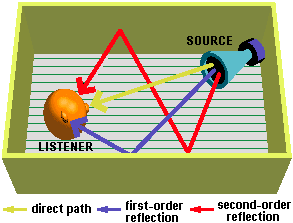Sound is produced when two or more objects collide, releasing a wave of energy which in turn forces changes in the surrounding air pressure. These changes in pressure are received by our eardrums, and our brain interprets them as sound. Sound waves move in all directions from the disturbance, like ripples produced when a stone is dropped into a pond.
When sound is recorded through a microphone, the changes in air pressure cause the microphone’s diaphragm to move in a similar way to that of the eardrum. These minute movements are then converted into changes in voltage. Essentially, all sound cards produce sound in this way, only in reverse. They create, or play back, sound waves. The changes in voltage are then amplified, causing the loudspeaker to vibrate. These vibrations cause changes in air pressure which are further interpreted as sound.
The human brain is a very cunning processor which in terms of audio can pretty much determine the location and condition of a sound given just two ears and the ability to turn using our head and body. The sound source could be a car engine, a mouth, a musical instrument, slamming door, or even a glass breaking as it hits the door. The source itself radiates the sound in a variety of ways – most of the sound out of a person’s mouth comes from where their face is pointing, whereas an engine radiates sound in pretty much all directions. Once the sound is radiated, the environment comes into play. The actual medium between source and listener greatly affects the sound, as anyone knows who has shouted on a windy day, or heard something underwater. Thus, the sound that is heard is a mixture of direct path sound and reflected sound. Reflected sound might reach our ears after bouncing off a wall or object, and the material of these obstacles absorbs certain frequencies, along with reducing the overall volume. This first-order reflection arrives not only sounding different from the direct source, but also slightly after it. Second-order reflections and so on take this effect further still. The quality and delay of the reflected sound reveals a great deal about the surrounding environment and its size.

Most humans can perceive precisely where first-order reflections are coming from, and some can distinguish second-order reflections too. However, as more and more reflections arrive at the ear, the brain tends to combine them into one late-order reflection echoing effect known as reverb. Using reverb properly is the first key to simulating different environments.
- How Do Computers Make Pictures?
- Graphic Card Resolution
- Graphic Card Colour Depth
- Graphic Card Components
- Graphic Card Memory
- Graphic Card Driver Software
- 3d Accelerated Graphic Cards
- Graphic Card Geometry
- 3D Rendering
- FSAA Graphic Card Technology
- Digital Graphic Cards
- DVI Graphic Cards
- HDCP Technology
- Graphic Card HDMI Ports
- Graphic Card Display Port
- Unified Display Special Interest Group
- DirectX
- OpenGL technology
- Direct3D
- Talisman
- Fahrenheit Graphic Cards
- SLI Technology
- CrossFire Graphic Cards